Inhibiting effect of I-phase formation on the plastic instability of the duplex structured Mg-8Li-6Zn-1.2Y (in wt.%) alloy
B.J.Wang ,D.K.Xu ,X.Q.Zhuang ,L.Y.Sheng
aSchool of Environmental and Chemical Engineering,Shenyang Ligong University,Shenyang,110159,China
b Key Laboratory of Nuclear Materials and Safety Assessment,Institute of Metal Research,Chinese Academy of Sciences,Shenyang,110016,China
c Peking University,Shenzhen Institute,Shenzhen Key Lab Human Tissue Regenerate & Repair,Shenzhen 518057,China
Abstract In this work,the tensile behaviors of Mg-8%Li and Mg-8%Li-6%Zn-1.2%Y alloys at ambient temperature were investigated and compared.It revealed that the plastic instability of Mg-8%Li alloy was quite remarkable and the variation range of serrated flowing stress can reach 5 MPa.For the Mg-8%Li-6%Zn-1.2%Y alloy,the formation of I-phase (Mg3Zn6Y) can simultaneously enhance the tensile strength and eliminate the plastic instability phenomenon,whilst its ductility was degraded.The in-situ tensile tests revealed that for the Mg-8%Li alloy,the severity and number of slip traces present in both α-Mg and β-Li matrix phases increased remarkably with the applied tensile strain.However,slip traces were quite fine in β-Li matrix phase and could be clearly observed when the applied tensile strain exceeded 18%.Due to the incompatibility of plastic deformation occurred in two matrix phases,the induced strain concentration at α-Mg/β-Li interfaces caused their subsequent cracking.For the Mg-8%-6%Zn-1.2%Y alloy,the I-phase distributed at α-Mg/β-Li interfaces suppressed the plastic deformation of α-Mg matrix phase and the tensile strain was dominated by the β-Li matrix phase,resulting in the disappearance of plastic instability.Moreover,the plastic strain would preferentially concentrate at I-phase/β-Li interfaces and subsequently induced the cracking of I-phase.
Keywords: Mg-li alloys;Microstructure;Plastic deformation;Basal slip;Cracking.
1.Introduction
So far,Mg-Li alloys being as the lightest structural materials have a density range of 1.25 ∼1.65 g/cm3and their applications can effectively solve the weight-reduction issues in engineering fields [1–7].However,their absolute tensile strengths are generally below 200 MPa even after being processed by severely plastic deformation (SPD) [8].To solve this issue,the icosahedral quasicrystal structured Mg3Zn6Y phase (I-phase) reinforced Mg-Li-Zn-Y alloys have been developed and their ultimate tensile strengths can be enhanced to 250 MPa [8,9].Moreover,the formation of I-phase in Mg-Li alloys is beneficial for improving the corrosion resistance[10] and thermal stability [11,12],weakening the mechanical anisotropy [9],enhancing the mechanical strength at elevated temperature [13].Thus,the I-phase reinforced Mg-Li-Zn-Y alloys have much high competitiveness and could be considered as promising lightweight structural materials for the applications in the engineering fields.
For Mg-Li series alloys,their crystallographic structures and phase component change with the added Li contents at room temperature[14,15].When Li content is below 5.5 wt%,the alloys are composed of theα-Mg phase with a hexagonal close-packed (HCP) structure.When Li content exceeds 10.3 wt%,the alloys will only be constituted ofβ-Li phase with a body-centred cubic (BCC) structure.When Li content is between 5.5 wt% and 10.3 wt%,the alloys have a typical(α-Mg+β-Li) dual phase structure.Recently,researchers reported that the plastic instability,i.e.“PLC” effect or serrated flowing phenomenon could widely present in tensile curves of HCP-structured Mg-Li based alloys at ambient temperature[16–21].Similarly,plastic instability could also occur in the conventional Mg alloys such as AZ91 [22],GZ31 [23] and WE54 [24].Owing to the occurrence of plastic instability phenomenon,sags and crests will be formed on the surfaces and finally result in the remarkable degradation in formability of Mg alloys [25,26].In the previous work,researchers mainly ascribed the occurrence of plastic instability to the dynamic strain ageing (DSA) [25,27].When the solute atoms have an equivalent diffusion velocity to the slip rate of activated dislocations,the plastic instability occurs due to the alternated pinning and unpinning of dislocations by the solute atoms [27,28].
Generally,the plastic instability occurs at the temperatures higher than 100 °C because the diffusibility of solute atoms changes remarkably with the temperature [24,28,29].Compared with traditional Mg alloys,the occurrence of DSA is much easier in Mg-Li alloys [19].For the Mg-4wt.%Li-1wt.%Al (LA41) alloy,the serrated flowing can be obviously observed at the whole plastic deformation stage of differently measured tensile curves at room temperature [17].For the BCC-structured Mg-14.3wt.%Li-0.8wt.%Zn alloy,the plastic instability occurred at 50 °C due to the occurrence of DSA[19].Therefore,it firmly demonstrates that the diffusibility of Li atoms inβ-Li phases is quite strong.Since the element Li is very active,the severe oxidation of the exposedβ-Li phases provides the driving force for the diffusion of Li atoms from the interior matrix [1].Generally,the intensity of DSA effect relies on the competition between the mobility of solute atoms and dislocation motion [30].When Li atoms have the equivalent diffusion rate to the slip rates of activated dislocations,the interaction between dislocations and Li atoms is strong.Therefore,the BCC-structured Mg-14.3wt.%Li-0.8wt.%Zn alloy exhibited obviously serrated flowing phenomenon only when the tensile testing was performed under the coordinated condition in terms of temperature and strain rate [19].Certainly,this mechanism should be also suitable for explaining the plastic instability occurred in the HCP-structured Mg-Li alloys.For the (α-Mg+β-Li) dual phase structured Mg-Li alloys,the diffusion rates of Li atoms in two matrix phases are significantly different.In addition,the plastic deformation mechanisms occurred in two matrix phases are different during the tensile process.Thus,the occurrence of their plastic instability should be dominated by the competition of DSA effects between the two matrix phases.In the previous work,it has been reported that after ageing treatment,the formed strengthening precipitates could eliminate the plastic instability of the HCP-structured Mg-4%Li-6%Zn-1.2%Y alloy [16].Compared with other phases in Mg-Li alloys,I-phase has much stronger strengthening effect and can remarkably retard the mobility of dislocations[8],which should be beneficial for weakening or inhibiting the DSA effects occurred in the matrix.Following this,it can be conjectured that the formation of I-phase in the duplex structured Mg-Li-Zn-Y alloy should be able to simultaneously enhance the mechanical strength and suppress the plastic instability.
On the basis of the above description,the following two questions need to be answered,i.e.1) for the plastic deformation mechanisms inα-Mg orβ-Li phases,which one determines the plastic instability occurred in the dual phase structured Mg-Li alloy? 2) whether the formed I-phase in the duplex structured Mg-Li-Zn-Y alloy can suppress the plastic instability or not? In this work,through performing the in-situ tensile testing to monitor the evolution of micro deformation mechanisms occurred in two matrix phases of the as-cast Mg-8%Li and Mg-8%-6%Zn-1.2%Y alloys,the proposed questions will be answered.Additionally,the cracking mechanisms of two alloys are discussed.
2.Materials and experimental procedures
The as-cast Mg-8%Li and Mg-8%Li-6%Zn-1.2%Y (in wt.%) alloys for the current investigation were fabricated by using vacuum furnace.After casting,the ingots were homogenized at 400 °C for 2 hrs.Phase analysis was performed by using a D/Max 2400 X-ray diffractometer(XRD).Microstructures of two alloys were observed by using scanning electron microscopy (SEM).
The final plate tensile samples were processed from the ingots and have a gauge section length of 25 mm,a crosssectional area of 4 mm × 3 mm,a radius between the gauge and grip sections of 8 mm.To clearly disclose the microstructural evolution and micro plastic deformation mechanisms occurred in two matrix phases,the tensile testing was performed at a strain rate of 1 × 10-4s-1on an in-situ mechanical testing system equipped with the stereo optical microscope(Keyence VHX 2000).Before the tensile testing,one side of wide surfaces of specimens was mechanically polished.During the tensile testing,the tensile strain was measured by using the attached strain gauge and the load acquisition was from the load cell of the tensile machine.Based on the technical parameters of the tensile machine,the resolution of load acquisition is less than ± 0.5%.After testing,the wide surfaces with a distance of 1 mm near to the fractured areas and the fractography of failed specimens were analysed by using SEM.To reveal the activation of twins in both two alloys,the polish wide surfaces of tensile tested samples were etched with an etching solution of (1 g picric acid +5 mL acetic acid +5 mL deionized water +15 mL ethanol) and subsequently observed by using optical microscopy (OM).
3.Results
3.1. Microstructural observations
Fig.1 shows the XRD patterns of the two alloys.It reveals that the Mg-8%Li alloy is constituted ofα-Mg andβ-Li phases.For the Mg-8%Li-6%Zn-1.2%Y alloy,the main phases areα-Mg,β-Li and I-phase.In the previous work,it has been reported that the addition of Zn and Y in Mg-Li based alloys can induce the formation of I-phase (Mg3Zn6Y)and W-phase (Mg3Zn3Y2) [8].Meanwhile,when the ratio between weight percent of Zn and Y was higher than 4.38,element Y would mainly exist as I-phase [8].Although the diffraction peaks corresponding to the W-phase can be hardly identified,small amount of W-phase should also be formed due to the nonequilibrium solidification.The microstructure of two alloys is shown in Fig.2.It exhibits that the Mg-8%Li alloy have a dual phase structure ofα-Mg andβ-Li(Fig.2(a)).For the Mg-8%Li-6%Zn-1.2%Y alloy,besides two matrix phases,I-phase is formed and preferentially distribute at theα-Mg/β-Li interfaces (Fig.2(b)).Moreover,for both two alloys,theα-Mg andβ-Li matrix phases appear in grey and dark respectively (Fig.2(a) and (b)).Since I-phase contains the higher atomic mass elements of Zn and Y,it appears in white under the backscatter electron imaging (BEI)mode.Additionally,Li et al.reported that for the as-extruded Mg-6%Li-6%Zn-1.2%Y alloy being performed solid solution treatment,fineα-Mg and MgLiZn particles could simultaneously precipitate inβ-Li phases during natural ageing process [12].Therefore,for the Mg-8%Li-6%Zn-1.2%Y alloy,the finely dispersed particles inβ-Li matrix phase areα-Mg and MgLiZn precipitates.Since the size of MgLiZn precipitates are quite small and their amount is small,XRD can hardly detect their existence.Based on the occupied areas ofα-Mg andβ-Li phases on sample surfaces,the volume fractions of two matrix phases are basically similar in both two alloys.
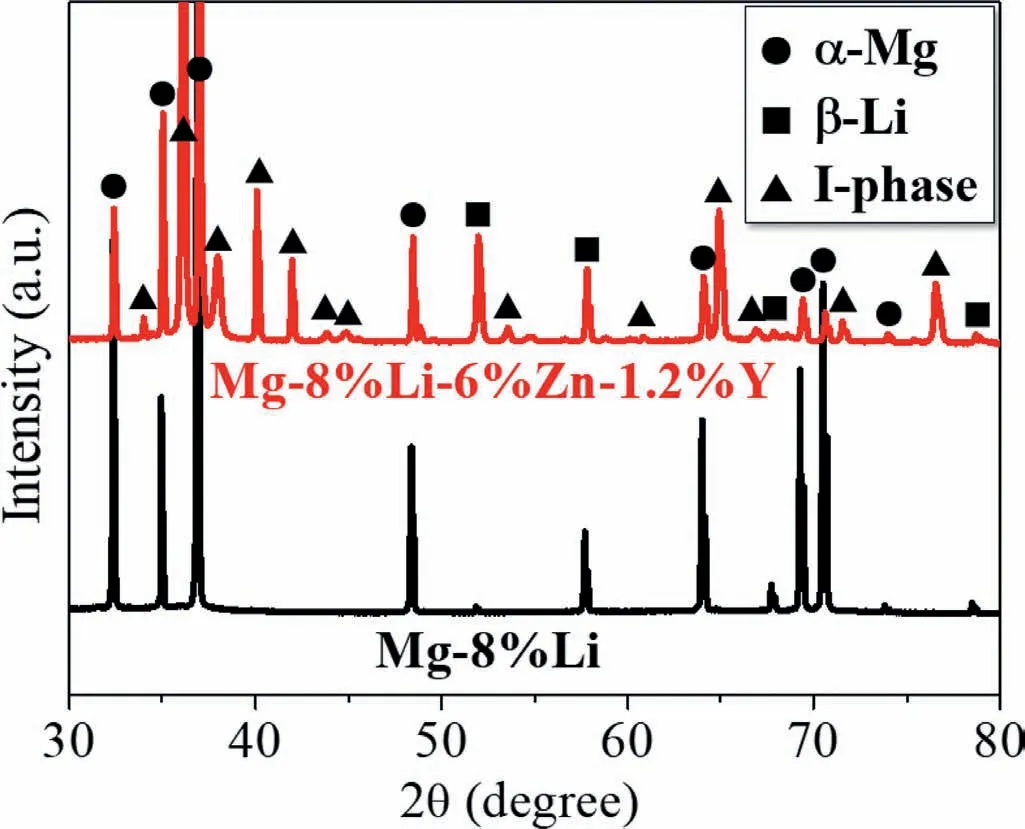
Fig.1.XRD patterns of the as-cast Mg-8%Li and Mg-8%Li-6%Zn-1.2%Y alloys.

Fig.2.SEM images with backscatter electron imaging mode: a) Mg-8%Li and b) Mg-8%Li-6%Zn-1.2%Y.
3.2. Tensile behaviour
Fig.3 shows the engineering tensile stress-strain curves of two alloys.Compared with Mg-8%Li alloy,the Mg-8%Li-6%Zn-1.2%Y alloy has the obviously higher tensile strength,whilst its ductility is relatively lower.To have a good comparison,the yield strength (σ0.2),ultimate tensile strength and elongation ratio are respectively determined to be 69 MPa,109 MPa and 43%for Mg-8%Li alloy and 101 MPa,147 MPa and 12% for Mg-8%Li-6%Zn-1.2%Y alloys.Moreover,the slope of elastic segment in the tensile curve of Mg-8%Li-6%Zn-1.2%Y alloy is relatively larger than that of Mg-8%Li alloy,indicating that the formed I-phase is helpful for the enhancement of elastic modulus.From the inserted highmagnified section of the tensile curve of Mg-8%Li alloy,obviously serrated flowing occurs at the plastic segment of tensile curve and the serrated amplitude of flowing stress can reach 5 MPa.However,the characteristics of plastic instability can hardly be observed in the whole tensile curve of Mg-8%Li-6%Zn-1.2%Y alloy.From the inserted high-magnified section of the tensile curve of Mg-8%Li-6%Zn-1.2%Y alloy,only small deviation steps with the maximum amplitude of 0.2 MPa can be observed,which is mainly due to the resolution of load acquisition from the load cell of testing machine.
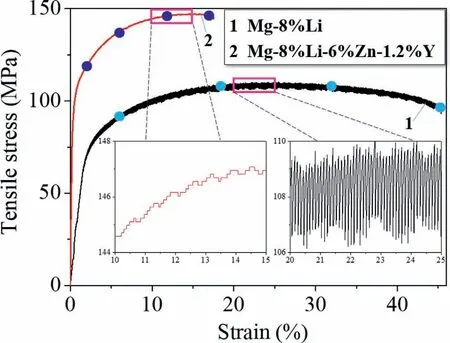
Fig.3.Tensile curves of the as-cast Mg-8%Li and Mg-8%Li-6%Zn-1.2%Y alloys.The inserted images are the high-magnified observation to the squared areas.The dots on the curves denote differently selected strains for the in-situ observations to sample surfaces.
3.3. In-situ microstructural observations during tensile testing
To clearly disclose the differently micro plastic deformation occurred in the two alloys,the in-situ observations to sample surfaces after being performed different tensile strains(labelled in Fig.3) are provided,as shown in Fig.4.

Fig.4.In-situ observations to the microstructural evolution after being performed tensile strains of: a) 6%,b) 18%,c) 32% and d) 45% for the as-cast Mg-8%Li alloy;e) 2%,f) 6%,g) 12% and h) 17% for the as-cast Mg-8%Li-6%Zn-1.2%Y alloy.
It can be seen that for the Mg-8%Li alloy,the whole plastic deformation is dominated by dislocation slips in theα-Mg andβ-Li matrix phases (Fig.4(a-d)).When a tensile strain of 6% is applied,slip traces can be clearly seen inα-Mg phase (Fig.4(a)).With the tensile strain increasing from 18%to 45%,the number of slip traces inα-Mg phase increases remarkably and fine slip traces can also be observed inβ-Li phase (Fig.4(b-d)).Due to the incompatibility of plastic deformation betweenα-Mg andβ-Li phases,severely localized plastic strain will concentrate atα-Mg/β-Li phase interfaces and intensifies with the applied tensile strain.For the Mg-8%Li-6%Zn-1.2%Y alloy,the plastic deformation of both two matrix phases is restricted by the I-phase.When a tensile strain of less than 6% is applied,the slip traces can hardly be observed in both two phases even some localized strain occurs at their interfaces (Fig.4(f)).With the applied strain increasing from 6% to 17%,the localized plastic strain atα-Mg/β-Li phase interfaces especially distributed with I-phase intensifies gradually and the slip traces in both two matrix phases can simultaneously occur and increase (Fig.4(g-h)).However,the slip traces inβ-Li phase are obviously denser than that inα-Mg phase,indicating that the tensile strain of the alloy is dominated by the plastic deformation ofβ-Li phase.
3.4. Failure diagnosis
Fig.5 shows the surface characteristics of tensile tested samples.It can be seen that for the two alloys,some micro cracks appear on the surfaces.For the Mg-8%Li alloy,cracks mainly initiate at theα-Mg/β-Li phase interfaces and along the slip traces inβ-Li phase (Fig.5(a)).Meanwhile,few cracks can also present in the interior ofα-Mg phase.For the Mg-8%Li-6%Zn-1.2%Y alloy,the formed cracks are mainly ascribed to the cracking of I-phase (Fig.5(b)).Fig.6 shows the fracture surfaces,revealing that deep plastic dimples are present on the fracture surfaces of both two alloys(Fig.6(a) and (c)).Based on the high-magnification images,micro secondary cracks can be observed at the bottom of dimples(Fig.6(b)and(d)).Backscattered electron imaging(BSE)observations reveal that for the Mg-8%Li-6%Zn-1.2%Y alloy,the micro cracks distributed at the bottom of plastic dimples are mainly ascribed to the cracking of I-phase particles(Fig.7(a) and (b)).Since the number of independent slip systems in traditional Mg alloys is less than five and cannot satisfy the Mises constraint on deformation compatibility,the {10–12}<10-11>extension twinning can be widely occurred during plastic deformation at room temperature [31–34].Fig.8 shows the etched microstructure of tensile tested samples.It can be seen that few twins are activated in the ascast Mg-8%Li and Mg-8%Li-6%Zn-1.2%Y alloys.Moreover,compared with Mg-8%Li-6%Zn-1.2%Y alloy,the plastic flow of two matrix phases in Mg-8%Li is more severe,resulting in their obvious elongation and preferential distribution along the tensile direction especially at the area close to the fracture surface (Fig.8(a)).

Fig.5.SEM images with backscatter electron imaging mode to the surfaces of tensile tested samples: a) Mg-8%Li and b) Mg-8%Li-6%Zn-1.2%Y alloys.
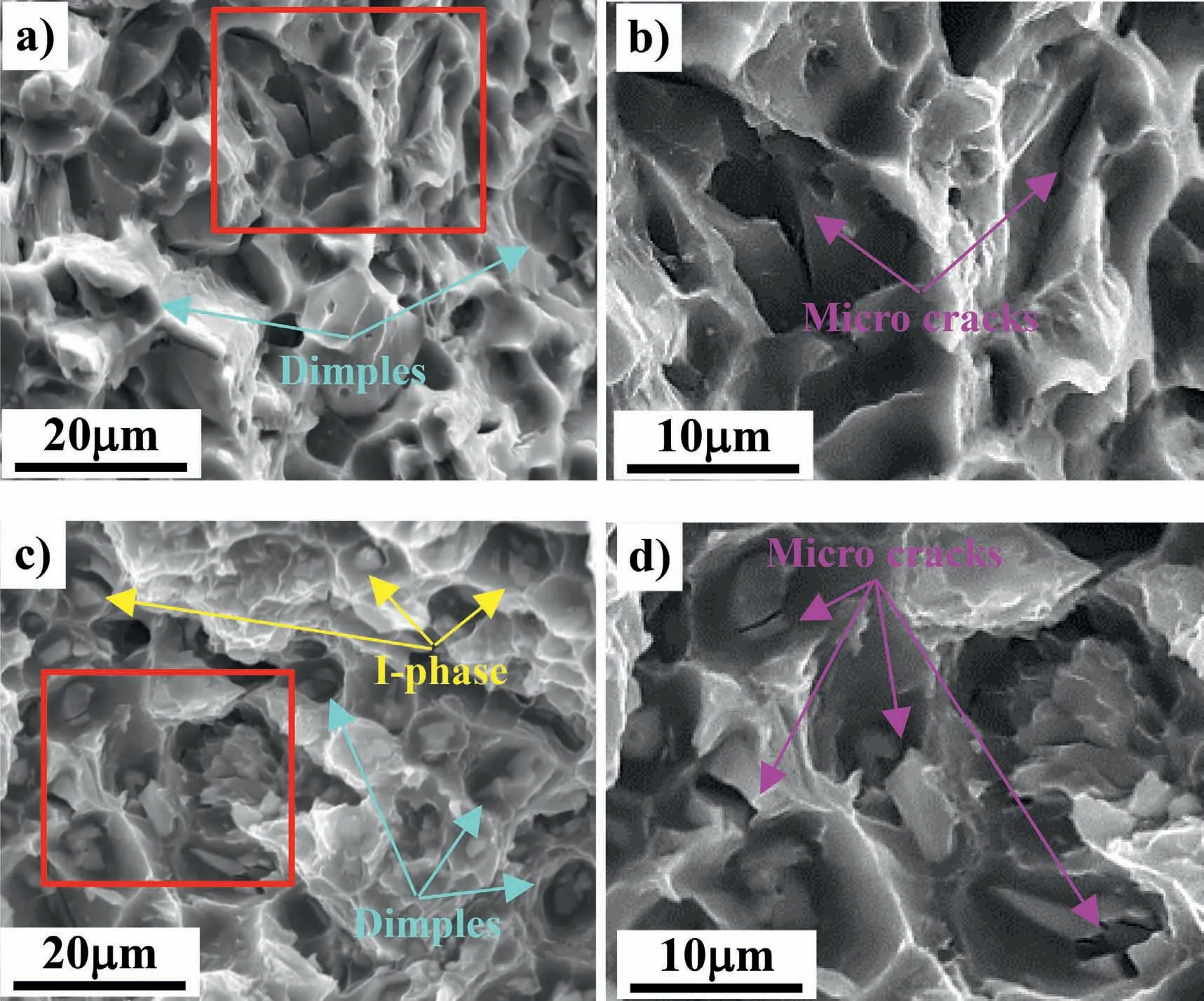
Fig.6.SEM images with secondary electron imaging mode to the fracture surfaces of a) Mg-8%Li and c) Mg-8%Li-6%Zn-1.2%Y alloys.Images (b) and (d)high-magnified observations to the areas squared in images (a) and (c),respectively.

Fig.7.SEM images with backscattered electron imaging mode to the fracture surfaces of Mg-8%Li-6%Zn-1.2%Y alloys.The locations of images (a) and (b)are respectively corresponding to those of (c) and (d),respectively.
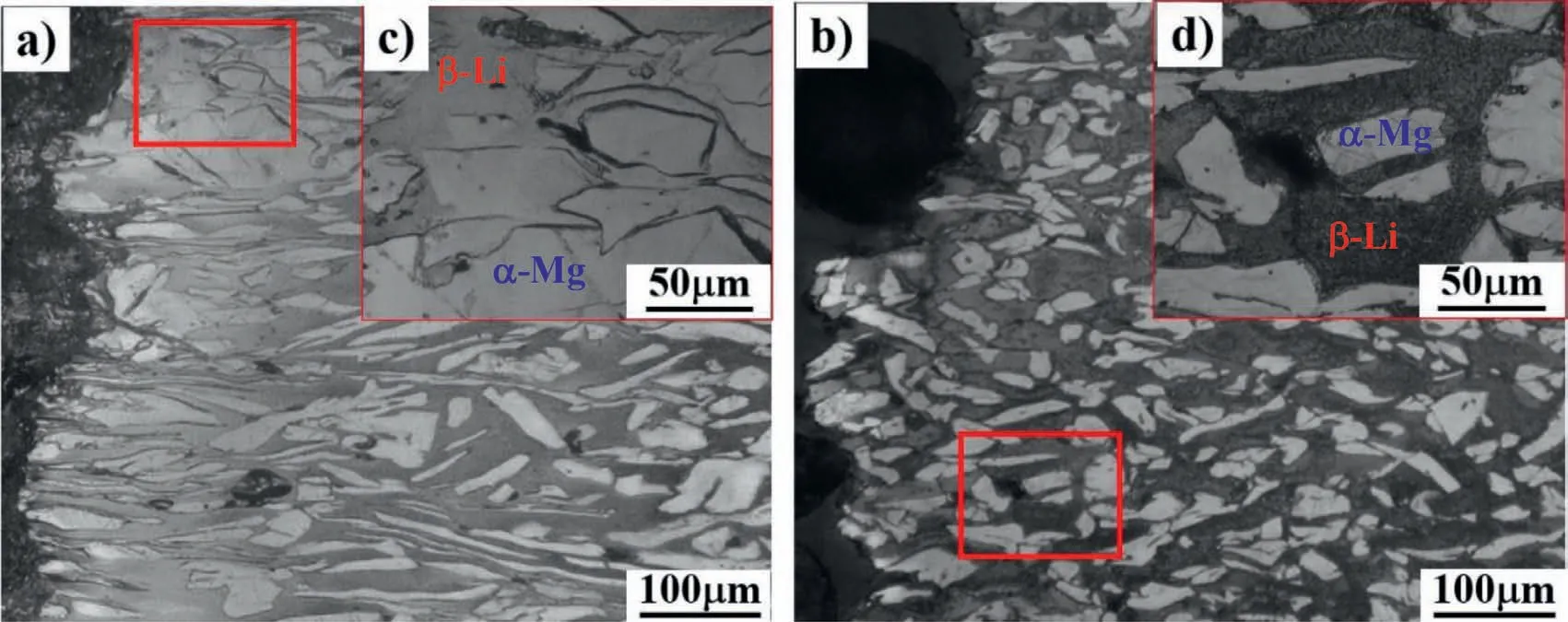
Fig.8.Optical observations to the etched polish wide surfaces of the tensile tested samples: a) Mg-8%Li and b) Mg-8%Li-6%Zn-1.2%Y alloys,c) and d)high-magnified observations to the areas squared in images (a) and (b),respectively.
4.Discussion
It has been reported that due to the addition of Li in Mg alloy,the c/a axial ratio of theα-Mg phase can be reduced from 1.624(pure Mg)to 1.607[35],which hinders the activation of {10–12} extension twin [36] but favors the activation of non-basal slip systems [37–41].Agnew et al.reported that the activities of pyramidal slips were significantly enhanced in Mg-Li alloys [37,38],and the competition between basal and pyramidal slip systems suppressed the activation of prismatic slip[39].Therefore,the activation of these non-basal slip systems can effectively accommodate the strain incompatibility in the HCP-structuredα-Mg matrix phase.In the research of the cyclic stress-strain response of the duplex structured Mg-8Li-3Al-3Ho alloy,Xie et al.reported that the determined hysteresis loop was symmetric because no obvious deformation twinning occurred and dislocation slips dominated the primary plastic deformation [42].In the current investigation,only few twins were activated in the as-cast Mg-8%Li and Mg-8%Li-6%Zn-1.2%Y alloys after being performed tensile testing (Fig.8).Therefore,for both two alloys,the plastic deformation is mainly accommodated by dislocation slips in theα-Mg andβ-Li matrix phases (Fig.4) and the effect of few activated twins in theα-Mg phase can be omitted.It has been reported that due to the high diffusibility of Li atoms inβ-Li phase,the occurrence of the DSA effect is relatively difficult and the temperature for causing the occurrence of plastic instability of the BCC-structured Mg-14.3Li-0.8Zn (in wt.%) alloy was lower than 248 K [43].On the contrary,for the HCP-structured Mg-Li alloys [16–21],the Li atoms inα-Mg phase could have an equivalent diffusion rate to that of dislocation movement.Then,the interaction between Li atoms and mobile dislocations is strong and can induce the repeated pinning/unpinning process of mobile dislocations inα-Mg phase.Due to this reason,the plastic instability occurred in Mg-8wt.%Li alloy is dominated by the plastic deformation mechanisms inα-Mg phase.Meanwhile,since the plastic deformation in two matrix phases is incompatible,the cracking nucleation will preferentially occur at theα-Mg/β-Li interfaces.In addition,for the duplex structured Mg-Li alloys,the strength ofβ-Li phase is much lower than that of theα-Mg phase [44].Haferkamp et al.reported that the yield strength of the BCC-structured Mg-Li alloys being composed ofβ-Li phase is lower than 60 MPa,which is only half of that of duplex structured Mg-Li alloys at room temperature[45].Thus,when the applied strain reaches to a certain level,many micro cracks can also nucleate along the slip traces in the interior ofβ-Li phase (Fig.5(a)).
For the Mg-8%Li-6%Zn-1.2%Y alloy,the formed I-phase and tiny W-phase at theα-Mg/β-Li interfaces can act as the fortress for retarding the plastic deformation of bothα-Mg andβ-Li matrix phases.Since the amount of the formed Wphase is quite tiny,its effect on the mechanical behaviour of Mg-8%Li-6%Zn-1.2%Y alloy can be neglected.Moreover,it has been reported that the precipitated MgLiZn particles were responsible for the age-softening response ofβ-Li matrix phase [11,12].As for the I-phase,it can have a semicoherency interface with theα-Mg matrix phase by periodically forming ledges and steps at theα-Mg/I-phase interfaces[46].Thus,theα-Mg/I-phase interfaces have strong atomic bonding strength and can effectively retard the dislocation movements [47],resulting in the remarkably enhanced tensile strength of Mg-8%Li-6%Zn-1.2%Y alloy.As described above,the plastic instability occurred in Mg-8%Li alloy is ascribed to the plastic deformation ofα-Mg phase.Since theα-Mg andβ-Li phases in Mg-8%Li-6%Zn-1.2%Y alloy are simultaneously surrounded by I-phase (Fig.2(b)),the dislocation movements in both two phases can be hardly activated even the applied tensile strain reaches 6% (Fig.4(f)).When the applied tensile strain is further increased,the strain will be dominated by the plastic deformation ofβ-Li phase because the ductility of the BCC-structuredβ-Li phase is much better than that of the HCP-structuredα-Mg phase.Moreover,previous work demonstrated that the interfaces between the I-phase and two matrix phases can effectively inhibit the diffusion of Li atoms in duplex Mg-Li based alloys at both room and elevated temperatures [11,12].Therefore,the plastic contribution from theα-Mg phase in Mg-8%Li-6%Zn-1.2%Y alloy during the whole tensile process is very small,resulting in the disappearance of plastic instability.Additionally,it has been reported that the elastic modulus could be influenced by the dissolved solute atoms and intrinsic modulus of the secondary phase [48].In the previous work,Garces et al.reported that the Young modulus of quasicrystal I-phase(Mg3Zn6Y)in Mg-Zn-Y alloys was measured to be 66 GPa [49].Therefore,the much higher Young modulus of Mg-8%Li-6%Zn-1.2%Y alloy can be attributed to the formed I-phase.However,due to the brittleness of I-phase,the cracking of I-phase will preferentially occur when the plastic strain cannot be accommodated,resulting in the ductility of the Mg-8%Li-6%Zn-1.2%Y alloy being much lower than that of Mg-8%Li alloy (Fig.3).
5.Conclusions
Through researching the plastic instability of duplex structured Mg-Li based alloys strengthening with and without Iphase,several conclusions can be reached.
1) The plastic instability of duplex Mg-Li based alloys is mainly determined by the plastic deformation ofα-Mg matrix phase.
2) I-phase formation can simultaneously enhance the mechanical strength and eliminate the plastic instability of Mg-Li based alloys.
3) Since theα-Mg andβ-Li phases are surrounded by Iphase in the Mg-8%Li-6%Zn-1.2%Y alloy,the plastic deformation ofα-Mg matrix phase is greatly restricted and the plastic strain is mainly accommodated byβ-Li matrix phase.
Acknowledgements
This work was supported by the National Natural Science Foundation of China Projects under Grant[Nos.U21A2049,51871211,52071220,5207011217 and 51701129],the National Key Research and Development Program of China under Grant [Nos.2017YFB0702001 and 2016YFB0301105],High level Achievement and Construction Project of Shenyang Ligong University (SYLUXM202105),Liaoning Province’s project of “Revitalizing Liaoning Talents” (XLYC1907062),the Doctor Startup Fund of Natural Science Foundation Program of Liaoning Province (No.2019-BS-200),the Strategic New Industry Development Special Foundation of Shenzhen (JCYJ20170306141749970),the funds of International Joint Laboratory for Light Alloys,Liaoning BaiQianWan Talents Program,the Domain Foundation of Equipment Advance Research of 13th Five-year Plan(61409220118),the Innovation Fund of Institute of Metal Research (IMR),Chinese Academy of Sciences (CAS),the National Basic Research Program of China (973 Program)project under Grant No.2013CB632205.
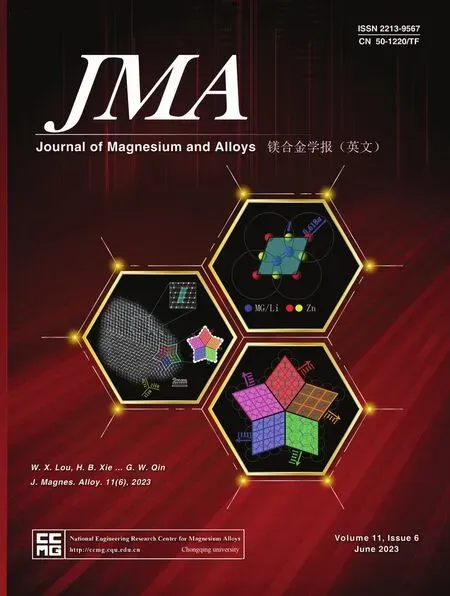 Journal of Magnesium and Alloys2023年6期
Journal of Magnesium and Alloys2023年6期
- Journal of Magnesium and Alloys的其它文章
- Carbon nanotube and graphene reinforced magnesium matrix composites:A state-of-the-art review
- Stress corrosion cracking of magnesium alloys: A review
- Simultaneous enhancement of mechanical properties and corrosion resistance of as-cast Mg-5Zn via microstructural modification by friction stir processing
- Effect of wire-arc directed energy deposition on the microstructural formation and age-hardening response of the Mg-9Al-1Zn (AZ91) alloy
- Regulating local coordination environment of Mg-Co single atom catalyst for improved direct methanol fuel cell cathode
- Hydrogen-induced optical properties of FC/Pd/Mg films: Roles of grain size and grain boundary
